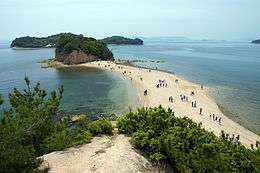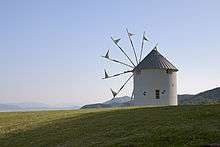Shōdoshima



Shōdo Island (小豆島 Shōdoshima) is an island located in the Inland Sea of Japan. The name means literally "Island of Small Beans". There are two towns on the island: Tonoshō and Shōdoshima, comprising the district of Shōzu.
The island is famous as the setting for the novel Twenty-Four Eyes, and its subsequent film adaptations. The island was the first area of Japan to successfully grow olives, and is sometimes known as "Olive Island".[1]
Geography
Shōdoshima is part of Kagawa Prefecture and is located north of the prefectural capital Takamatsu. It has an area of 153.30 km2 (59.19 sq mi) and a coastline of 126 km (78 mi). It is the 19th largest island in Japan, and the second largest in the Inland Sea.
Shōdoshima is home to Dobuchi Strait (土渕海峡 Dobuchi-kaikyō) the world's narrowest strait, 9.93 m (32.58 ft) meters at its narrowest.
Frequent ferries run to the island from Takamatsu, Himeji, Teshima and Okayama. Ferries run infrequently to Osaka and Kōbe as well.
History
Shōdoshima was once known as Azuki-shima and was part of Kibi (later Bizen) Province, given to Sanuki Province, and finally made part of Kagawa prefecture.
Tourism and culture
Shōdoshima is a popular destination for domestic tourism in Japan. In addition to natural features such as the Dobuchi Strait, the Angel Road, Shōdoshima Olive Park and the Kanka Gorge (寒霞渓 Kanka-kei), Shōdoshima is famous as the setting for the antiwar novel Twenty-Four Eyes (二十四の瞳 Nijūshi no Hitomi), written by the native author Sakae Tsuboi and later turned twice into a film (1954 and 1987), as well as a television special.[2][3] The island is the birthplace of two other distinguished writers: Sakae's husband the poet Shigeji Tsuboi and the novelist and short-story writer Denji Kuroshima. All three were prominent participants in the proletarian literary movement, an important and politically radical current within modern Japanese literature.
Shōdoshima is also known for its olives, soy sauce, wild monkeys, and beaches. In addition, tourists are attracted to a miniature version of the 88-temple Shikoku Pilgrimage.
The island is also famous for being the first in Japan to successfully cultivate olives. Olive trees proliferate on the island and olive-related merchandise is quite popular with tourists.[1] Milos, Greece is Shōdoshima's sister island.
Sister island

See also
Notes
- 1 2 Singleton Hachisu, Nancy (30 October 2015). "The island making Japan's best olive oil". The Japan Times. Retrieved 1 November 2015.
- ↑ "Twelve Sets of Eyes". TMS Entertainment. Retrieved 30 August 2011.
- ↑ 二十四の瞳 (in Japanese). TMS Entertainment. Retrieved 30 August 2011.
External links
| Wikimedia Commons has media related to Shodo Island. |
Coordinates: 34°30′49″N 134°17′08″E / 34.51361°N 134.28556°E
